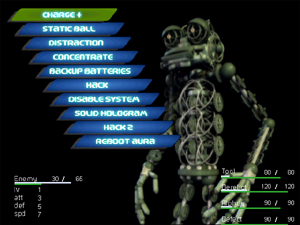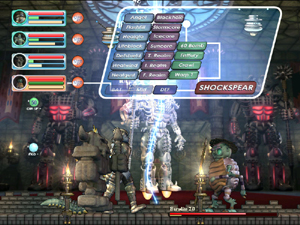 |
 |
 |  |  |  | | How will I kill thee? Let me count the ways. |  |
The Desolate Room is a great game, and you really should stop reading this and get to downloading if you haven't tried it yet. It takes the traditional jRPG battle system and throws grind out the window by giving your team access to their full range of interesting and varied powers from the get-go. Most enemies are way too tough to take down by just haphazardly making attacks. To win you need a strategy that combines your party's skills to short circuit the enemy's powers. Leveling up mainly serves as a means of augmenting your chosen strategy, and the gains are pretty marginal. The result is something I would have thought impossible: a jRPG that tests your skill instead of your patience.
On that note, let's look at two recent indie RPGs that follow in the Desolate Room's wake, one that gets things beautifully right, and one that gets things horribly, horribly wrong.
The Spirit Engine 2 is a shareware game that takes the strategic combat of The Desolate Room, combines it with the timing of Magi, then runs with it. Your party consists of three characters from three possible classes: Knight, Musketeer, and Priest. The game throws away any pretense of not being linear by having you travel from left to right across a series of 2d rooms peppered with enemies, treasures, and plot points. Combat consists of the three (sometimes four) of you standing single file and facing off against a collection of motley monsters, mutants, and dumb schmucks. Green energy bars build up for each party member over time and when they are full, the character uses whatever skill/attack/spell was currently selected. Enemies and party members who are KO'd will automatically revive with minimal hitpoints after a certain amount of time has passed, so the way you win (or lose) is by having all the units on the other side KO'd at the same time. Go.
TSE2 only aims to do one thing, and it does that very well. Once the tutorial chapter is finished and you get a feel for how the combat system works, the game proceeds to explore the limits of this system every step of the way with a menagerie of unique and tactically interesting enemies. You know how in the final fantasy games they would occasionally take a break from the legions of palette-swapped imps and slimes with an enemy (usually a boss) who was immune to magic or dealt automatic reprisal damage to an attacker? How these enemies would force the player to mix up their otherwise brainless and automatic battle plan? In TSE2 every enemy brings a unique wrinkle like that to combat, forcing you to rethink and re-evaluate your strategy every step of the way. From cthuloid elephants that deal massive damage to nearby units when they collapse to the ground, to zombies that revive from a KO REALLY FAST, to creatures so heavily armored your whole team has to concentrate their energies in one super attack just to make a dent. Even on Easy mode, if you wade into battle against a new enemy without adapting your strategy, chances are you'll get your ass handed to you.
To counter this, each class has a wide a versatile selection of skills with an experience system that encourages evenly distributing upgrade points instead of jacking one or two skills to the max. It's really clever how all three classes can perform the same task, but go about it in very different ways. For example, you need to rotate your party constantly during a battle so everyone needs to be a blocker for a while. Knights do this by having the highest hit points and the strongest armor. Musketeers have low HP and okay armor, but have a high percent chance of dodging an attack entirely. Priests have low HP and lousy armor, but they have a regenerating buffer of "Chi" hitpoints that absorb physical damage, as well as a percentage-based magic resistance. So if you want to play through the game with a party of 3 priests it's not only a viable strategy, but you will have the three priests taking on very different roles and using different skills in combat.
The plot is decent. It's your usual jRPG soap opera about a party of misfits "finding themselves" in the midst of a cross-country homicidal rampage. In the background a cold war between paranoid self-hating Americans and saucy cigarette-smoking Frenchmen threatens to boil over while shadowy forces secretly plot to take over the world. No one starts spurting stigmata or drawing parallels between Norton Utilities and the Book of Revelations, so the story's already way better than half the jRPGs out there. The main draw here is the fact that there are 9 characters to choose from, and while the general plot progresses the same way no matter who you pick, the individual plot points change depending on the characters in the group, with lots of specific individual exchanges between certain pairs. It may be cliche, but it manages to stay interesting. If all you want is the combat, every cutscene is skippable.
Like I said before, this game aims to do one thing, and it does that very well. My gripes with the game are few and niggling and for a measly $18 it's a steal.
 |  |  |  | | Very Pretty. But can they fight?
|  |
Iffermoon is the latest freeware creation by the author of the Desolate Room. I really wanted to like this game. It definitely has the more interesting setting of the two, with a planet of bizarre creatures besieged by the creations of their fallen machine demiurge, one of which is the protagonist. The graphics are gorgeous and the world created is surreal and beautiful. Unfortunately this is all weighed down by some insanely terrible design decisions.
What was your favorite part of The Desolate Room? Was it the complex combat system, or the parts in between where you guide the coffee machine robot as it wanders the island waiting the the random number generator to cough up some eggs to give your team a necessary boost in their next fight? For god-knows-what reason, the creator of this game dumbed down the combat mechanics and increased the foraging grind by a factor of 10. Combat consists of your characters meandering around and automatically making physical attacks while you activate spells. Most characters start with no spells and gain only a single new spell per level. And the spells I've seen are boring. Here's a fireball spell, here's a spell that temporarily makes firespells do more damage, here's a slow spell. What happened to the doom laser that puts the enemy on a death timer, the vapor that turns bosses into inoffensive toys, or the hacking minigames?
Instead the game gives you endless piles of busywork. You see, new characters won't join your party unless you perform a quest for them, and by "perform a quest" I mean "do their chores." Literally. There is one character that requires you to wander through the castle picking up garbage, and will only join you once the random number generator has given you about 100 pieces of garbage. I don't get how a travesty like this survives the production process. In a sane world, when a designer creating a video game writes, "pick up trash" he should immediately cap his pen, crumple up the paper, then burn it. But this guy not only left it on his design, he coded picking up the trash into the game, AND spent the time rendering multiple "garbage" sprites! Has the world gone mad?
Besides lousy combat and doing chores, the game also features three minigames: a crappy shmup, a blah "toobin" remake, and a sub-par Dragon Warrior. These minigames yield important and unique skills and items necessary for the combat, so they're not optional. The shmup in particular is a perfect example of what's derisively referred to as "euroshmups." A shooting game with boring repetitive formations of enemies with very well-rendered sprites, flashy but woefully underpowered weapons, and a terrible case of "Gradius syndrome" if you get killed and lose your weapons because you can never go back to the easy levels.
It's released freeware and I can definitely appreciate it as a coding project for a programmer who wants to see if he can fit all these elements into one exe. But as a game it's a total failure, made all the more disappointing by its fantastic predecessor.
The lesson to be learned from this? Better to do one thing and do it well than attempt to do a zillion little things and fail at them all. Let's hear it for the challenging and grind-free RPGs of the future.
 Mischief Maker Mischief Maker
|  |
|
|

